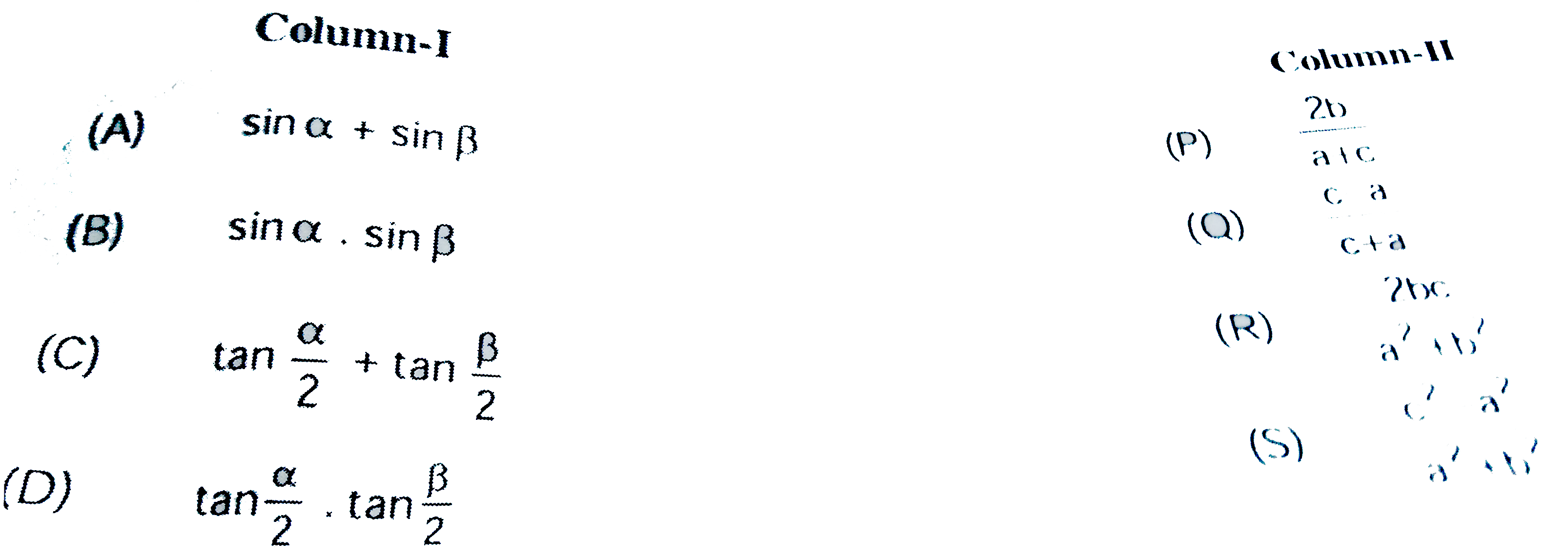α,β হল acosθ+bsinθ=c সমীকরণের দুটি ভিন্ন বীজ, a,b,c তিনটি বাস্তব সংখ্যা এবং θ∈[0,2π] | সেক্ষেত্রে α+β ঐ সমীকরণের আরেকটি বীজ হবে যদি
a+b=c
b+c=a
c+a=b
c=a
Step by step video & image solution for alpha,beta হল acostheta+bsintheta=c সমীকরণের দুটি ভিন্ন বীজ, a,b,c তিনটি বাস্তব সংখ্যা এবং thetain[0,2pi] | সেক্ষেত্রে alpha+beta ঐ সমীকরণের আরেকটি বীজ হবে যদি by Maths experts to help you in doubts & scoring excellent marks in Class 11 exams.
Updated on:21/07/2023Topper's Solved these Questions
- ত্রিভুজের ধর্মাবলিBOOK - CHAAYA PRAKASHINI (BENGALI)CHAPTER - ত্রিভুজের ধর্মাবলিEXERCISE - JEEMAIN
5 Videos
- ত্রিভুজের ধর্মাবলিBOOK - CHAAYA PRAKASHINI (BENGALI)CHAPTER - ত্রিভুজের ধর্মাবলিEXERCISE - JEEADV
4 Videos
- ত্রিভুজের ধর্মাবলিBOOK - CHAAYA PRAKASHINI (BENGALI)CHAPTER - ত্রিভুজের ধর্মাবলিEXERCISE - WBHS
33 Videos
- ত্রিকোনমিতিক অপেক্ষকের সমীকরণসমূহের সাধারণ সমাধানBOOK - CHAAYA PRAKASHINI (BENGALI)CHAPTER - ত্রিকোনমিতিক অপেক্ষকের সমীকরণসমূহের সাধারণ সমাধানEXERCISE - EXERCISE
124 Videos
- ত্রিমাত্রিক স্থানাঙ্ক জ্যামিতিBOOK - CHAAYA PRAKASHINI (BENGALI)CHAPTER - ত্রিমাত্রিক স্থানাঙ্ক জ্যামিতিEXERCISE - EXERCISE
231 Videos
Similar Questions
কোনো স্তম্ভের পাদবিন্দু থেকে অঙ্কিত সরলরেখার ওপর অবস্থিত তিনটি সমরৈখিক বিন্দু A,B এবং C থেকে স্তম্ভের শীর্ষের উন্নতি কোণ যথাক্রমে 30∘,45∘এবং 60∘ হলে AB:BC এর মান হবে–
View Solutionদেখাও যে, a(bcosC−ccosB)=b2−c2
View Solution3sinθ+4cosθ=5 হয়, তবে 4sinθ−3cosθ=
View Solutioncosθ=0 সমীকরণের সাধারণ সমাধান হয়―
View Solutionসঠিক উত্তরটি নির্বাচন করো
yzসমতলের উপরিস্থিত যে-কোনো বিন্দুর স্থানাঙ্কের আকার হয়—
View SolutionIf alpha,beta are non-real roots of ax^(2)+bx+c=0,(a,b,c in R), then (A)alpha beta=1(B)alpha=beta(C)(a beta)/(alpha beta)=1(D)alpha=bar(beta)
View SolutionLet α,β are the root of equation acosθ+bsinθ=c.
Which of the following is/are true.
View SolutionLet α,β are the root of equation acosθ+bsinθ=c.
If α=30∘ and β=60∘ such that a,b,c represent sides of a ΔABC then
View SolutionIf α and β are the roots of the equation, acosθ+bsinθ=c, then match the entries of column I with the entries of column- II

View Solutionacosθ+bsinθ=c সমীকরণ α,β(α≠β) দ্বারা সিদ্ধ হলে tanα+β2 -এর মান হবে—
View Solutionax+by+c=0,bx+cy+a=0এবংcx+ay+b=0 সরলরেখা তিনটি সমবিন্দু হবে যখন—
View SolutionIf α,β are the roots of ax2+bx+c=0, αβ=3 and a, b, c are in A.P., then α+β =
View SolutionIf α and β are distinct roots of acosθ+bsinθ=c, prove that sin(α+β)=2aba2+b2
View SolutionIf αandβ are roots of the equation acosθ+bsinθ=c then prove that,
sin(α+β)=2aba2+b2
View SolutionLet α,β be two distinct roots of acosθ+bsinθ=c, where a, b and c are three real constants and θ∈[0,2π]. Then α+β is also a root of the same equation if
View Solutionযদি a, b, c বাস্তব হয়, তবে (x-b)(x-c) + (x-c)(x-a) + (x-a)(x-b) =0 সমীকরণের উভয় বীজ সর্বদা
View Solution
